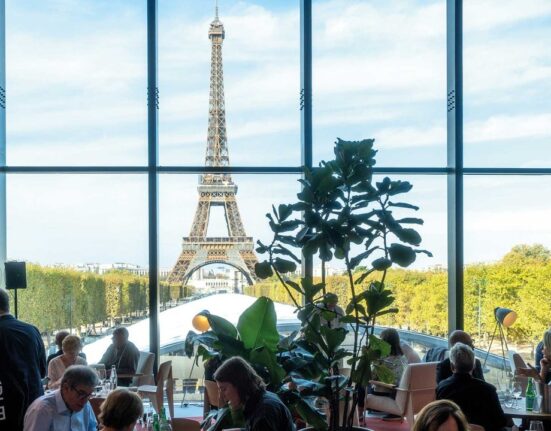Museums periodically revamp displays of their permanent collections to freshen up the visitor experience and lure back audiences. With a new show, which opened in February, the Brooklyn Museum has done exactly that — and more.
The museum, which has a permanent collection of about 6,000 works of European art, has redisplayed some of its 19th- and 20th-century pieces in a fifth-floor gallery, bringing together work it had previously showcased in its vast Beaux-Arts Court, a space with a giant chandelier and a glass floor, and pieces that had been part of a traveling exhibition.
The resulting show of 89 works — “Monet to Morisot: The Real and Imagined in European Art,” which will be on view through May 21, 2023 — has given the museum an opportunity to re-examine its holdings through a 21st-century lens.
One of the main wall texts explains the museum’s rationale for the revamping.
“Like most U.S. collections built during the 19th and 20th centuries,” it reads, “the Brooklyn Museum’s European holdings from this period consist primarily of works by white male artists, with only a handful by women artists and none by artists of color.”
The gender- and race-conscious rehang was “an opportunity to connect this work with the present-day conversation,” said Anne Pasternak, the museum’s director. She said staff members had been fielding questions from visitors about provenance, the environment, economic inequality, gender and race.
When Ms. Pasternak was an art history student in the 1990s, the field “was only discussed in terms of formal qualities” such as color and light, she said.
But, she added, “These artists were all artists of their time. They were reflecting on issues of labor and industry, and societal changes. Why wouldn’t our installations reflect that?”
Lisa Small, the museum’s senior curator of European art, who oversaw the redisplay, said the 19th- and 20th-century European collections were narrow in scope and not diverse, so her job was to “move past these constraints” and be “very transparent about systems of taste, systems of collecting, systems of patronage, all of which have long been classed, raced, gendered.”
That mission could have resulted in a preachy exhibition, one in which the message overshadowed the art. Yet “Monet to Morisot” is a thoughtful thematic promenade through a collection that includes a number of gems, among them Claude Monet’s “The Doge’s Palace” (1908), Pierre Bonnard’s “The Breakfast Room” (circa 1925) and Henri Matisse’s “Nude in a Wood” (1906).
Some of the paintings, such as the Monet, are not relevant to 21st-century discussions around gender and race. Others are.
Consider, for instance, Jean-Léon Gérôme’s “The Carpet Merchant of Cairo” (1869), an oil painting that depicts a carpet merchant at a bustling bazaar in the Egyptian capital.
To return to the “real and imagined” language of the exhibition’s title, the carpet vendor certainly seems to be an invention: His costume, the sumptuous silks and rugs draped over his shoulder, and the robed and veiled figures in the background are figments of the Orientalist painter’s imagination. Yet, at the time, European audiences considered them accurate representations of the East.
“Right away, you have that sense of distance, of othering,” said Ms. Small, “that ethnographic ‘look at this type of person that has a different skin color or a different physiognomy, and who lives according to such different customs than our own.’”
Another painting in the collection that is perceived differently today is Edgar Degas’s unfinished “Nude Woman Drying Herself” (circa 1884-86).
Ms. Small said Degas invited models into his studio to pose in a basin he had set up, and that he would ask them “to just go about their washing as though they were alone.”
The resulting paintings and pastels were “very naturalistic in terms of how a body would bend and move,” she said. Yet, she added, “they do have a very voyeuristic quality,” especially as the subject is often looking away, and “the gaze is all ours.”
The Brooklyn Museum made headlines in 2020 when it raised nearly $40 million for the upkeep of its collection by deaccessioning, or selling, some of its works. The ethics of deaccessioning have been hotly debated; that same year, after a major uproar, the Baltimore Museum of Art canceled the planned sale of three works in its collection.
Ms. Pasternak said the Brooklyn Museum had an endowment worth less than $200 million.
Without additional funds, she said, “every time there’s an economic downturn, you have the risk of losing important people who care for the collection, like conservators and art handlers and registrars.”
The works that were sold in 2020 were “outliers in our collection, or lesser examples of artists’ works,” she said, adding that the museum had a policy never to sell contemporary art by living artists, and never to sell major works.
Since those sales, the Brooklyn Museum has added nearly 500 new pieces to its collection, dating from the sixth century to the present day. Most of them, the museum said, were gifts.
Among them is a 1793 portrait of a countess by Elisabeth Louise Vigée-Lebrun, a French portrait painter of the late 17th and early 18th centuries who is one of the few female artists of her day to have her work taught in art history classes, studied and shown in museums.
Another is “Portrait of a Man of African Descent” (circa 1600), by an unknown artist. In a news release announcing the acquisition, the museum described the work as “a rare and compelling portrait of an as-yet-unidentified Black man” that had “none of the typical signifiers of servitude.”
The portrait, the release said, opened up “inclusive narratives about the presence of Black people in early modern Europe — some having arrived as pilgrims or members of diplomatic retinues,” and offset perceptions of 17th-century Europe as being “an almost exclusively white milieu.”
Ms. Small said that after “Monet to Morisot” is taken down next year, the next redisplay would focus on religious imagery from the Italian Renaissance but also works from Peru and other territories under Spanish rule.
Again, she said, the museum would use the opportunity to recontextualize the works — “thinking about art under colonial rule, the violence of that contact,” and “the imagery that emerges from that religious conquest.”







